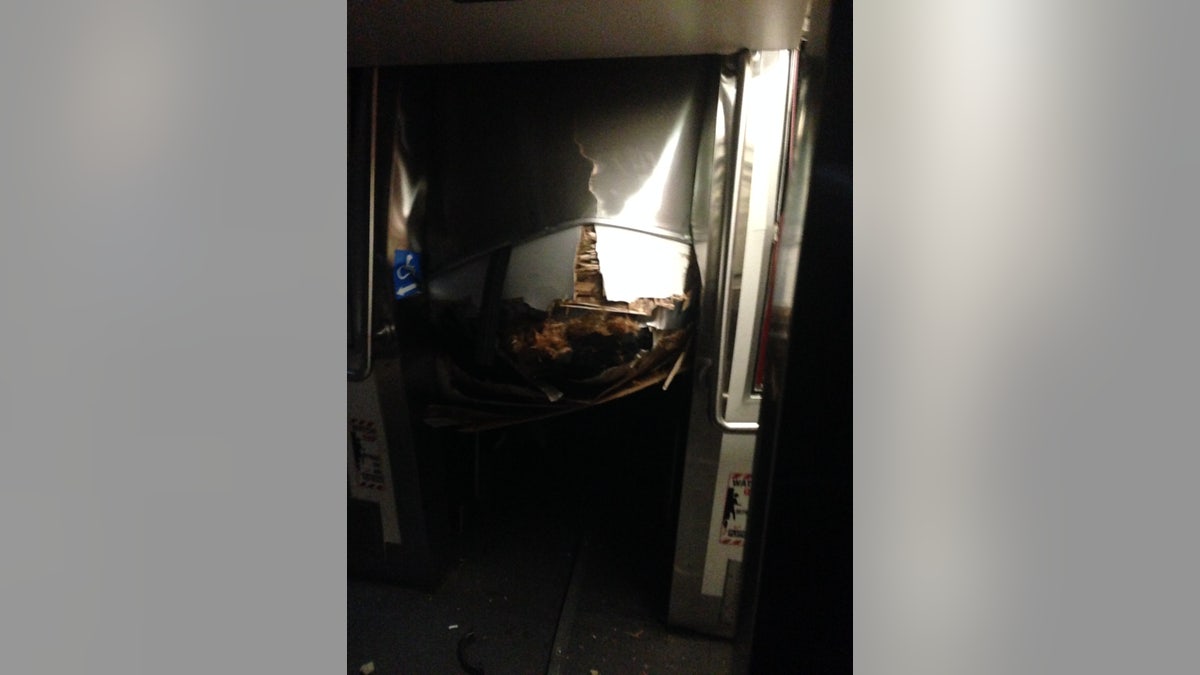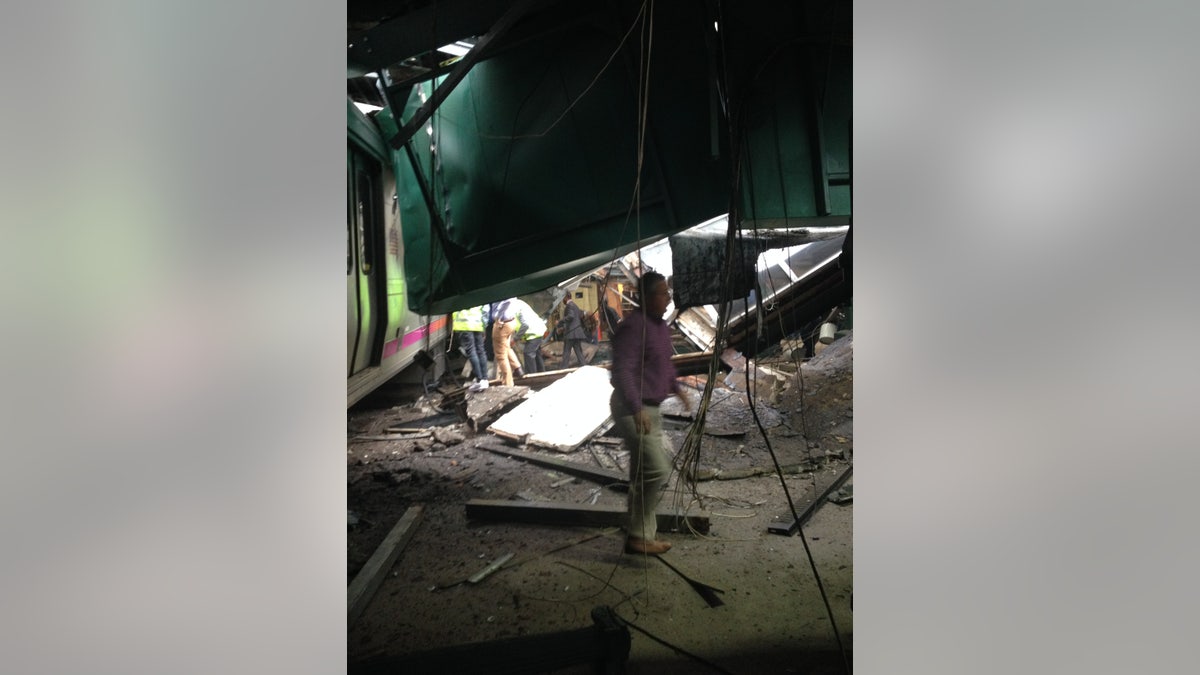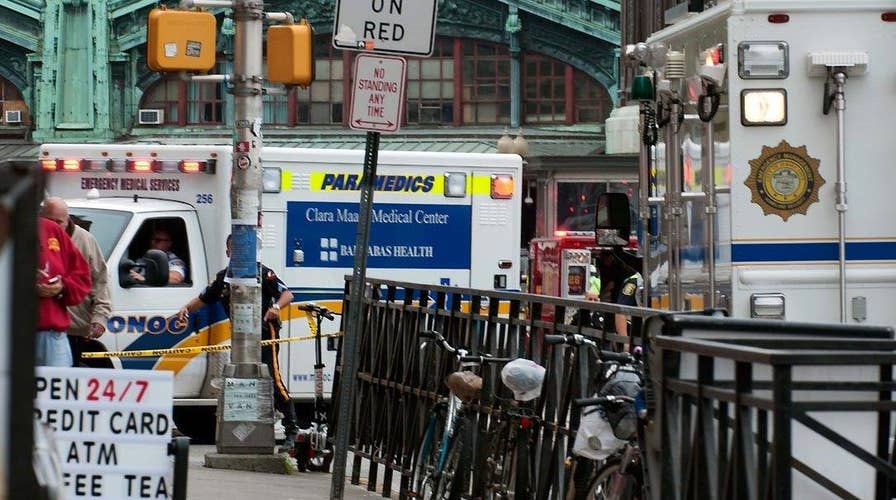A woman was killed and 108 others were injured when a crowded commuter train crashed through a barrier at the busy Hoboken, N.J. station and lurched across the waiting area during the height of the Thursday morning rush hour.

The collapsed roof inside the first train car. (Dave Mielach)
The New Jersey State Medical Examiner's office identified the deceased victim as Fabiola Bittar de Kroon, 34, of Hoboken. She worked for software company SAP in its legal department in Brazil but left earlier this year. SAP spokesman Andy Kendzie said the company was "shaken by the news" of de Koon's death and offered condolences to her family, friends and all those affected by the "tragic event."
Earlier, New Jersey Gov. Chris Chrstie told reporters the woman who died had been standing on a nearby platform and was hit by debris from the crash. The New Jersey Transit train ran off the end of its track as it pulled into the station, smashing through a concrete-and-steel bumper. It apparently knocked out pillars as it ground to a halt in the waiting area, collapsing a section of the station roof onto the train.
Scene at Hoboken NJ Transit Terminal right now. Tons of police and first responders. https://t.co/GSpyGFO9rx
— Noah Zucker (@noahlz) September 29, 2016
"All of a sudden, there was an abrupt stop and a big jolt that threw people out of their seats. The lights went out, and we heard a loud crashing noise like an explosion" as the roof fell, said Ross Bauer, who was sitting in the third or fourth car when the train entered the historic 109-year-old station, a bustling hub for commuters heading to New York City. "I heard panicked screams, and everyone was stunned."
Commuter Jim Finan, of River Edge, N.J., told Fox News' "America's Newsroom" that the train barreled into the station in "at full tilt" and "never slowed down."
Massive train crash at #Hoboken Path Station. Injuries reported. Train apparently ran full force into station. pic.twitter.com/rgt9pycnL4
— Nicolette (@NewsNicolette) September 29, 2016
William Blaine, an engineer for a company that runs freight trains, was inside the station and ran over to help. He told the Associated Press he saw the train's engineer slumped over the controls.
Finan described the crash as feeling like he was "in an off-road vehicle," adding, "It was bumpy. You were getting bounced around and then slammed forward."
"People were running up the stairs to get out," with "others pushing to get through first," WFAN Radio sportscaster John Minko, who was at the station, told Fox News.
Late Thursday, New Jersey Transit identified the engineer as Thomas Gallagher, a 29-year agency veteran. A union roster shows Gallagher started as an engineer about 18 years ago.
National Transportation Safety Board (NTSB) Vice Chairman Bella Dinh-Zarr told reporters Thursday afternoon that Gallagher had been released from the hospital and was cooperating with investigators.
"We have no indication that this is anything other than a tragic accident," Christie said.
"The train came in at much too high rate of speed," Christie added, "and the question is: 'Why is that?'"

Crews at the crash site. (Dave Mielach)
Some witnesses said they didn't hear or feel the brakes being applied before the crash.
Dinh-Zarr said investigators were being hampered by safety issues, but were expected to retrieve the train's data recorder Thursday evening. She added that water has been leaking in all day and there may also be asbestos contamination because of the age of the station building.
CLICK HERE FOR COVERAGE FROM FOX 5 NEW YORK
People pulled concrete off bleeding victims and passengers kicked out the windows amid crying and screaming. Jersey City Medical Center received 66 patients from the crash, according to officials who said 13 people were in "guarded" condition. Doctors said they expected all the remaining patients to survive.
Hoboken University Medical Center received 23 patients, all but seven of whom had been released Thursday evening. The injuries included broken bones and head wounds. Another patient was recovering at Christ Hospital in Jersey City.
"When you see the damage and destruction, and you know how many people were on the platform, it's amazing there was only one fatality," New York Gov. Andrew Cuomo told Fox News' "Your World with Neil Cavuto." "It could have been much worse."
Speaking to Fox News, Christie praised the "seamless, professional" response from emergency workers in the minutes and hours after the crash.
None of NJ Transit's trains is fully equipped with positive train control, a safety system designed to prevent accidents by overriding the engineer and automatically slowing or stopping trains that are going too fast. Positive train control relies on radio and GPS signals to monitor trains' positions and speed.
The NTSB has been pressing for some version of the technology since at least 1990, and the industry is under government orders to install it, but regulators have repeatedly extended the deadline at railroads' request. The target date is now the end of 2018.
"While we are just beginning to learn the cause of this crash, it appears that once again an accident was not prevented because the trains our commuters were riding lacked positive train control," said Rep. Sean Patrick Maloney, D-N.Y. "The longer we fail to prioritize investing in rail safety technology, the more innocent lives we put in jeopardy."
But both Cuomo and Christie said that it is too soon to say whether such technology would have made a difference in the Hoboken crash.
Over the past 20 years, the NTSB has listed the lack of positive train control as a contributing factor in 25 crashes. Those include the Amtrak wreck last year in Philadelphia in which a speeding train ran off the rails along a curve. Eight people were killed.
NJ Transit trains do have an alerter system — a sort of dead man's device — that can sound a loud alarm and then stop a train if the engineer goes approximately 15 to 20 seconds without adjusting the controls. But it is not clear whether that would have made a difference either.
The train was not equipped with an inward-facing camera in the cab that could give a fuller picture of the operator's actions.
The train consisted of four passenger cars and a locomotive at the rear. Passengers said it was crowded, with standing room only in the typically popular first few cars, but authorities had no immediate estimate of how many were aboard.
The Hoboken terminal handles more than 50,000 train and bus riders daily, many of them headed into New York City. After arriving at Hoboken, they take ferries or PATH commuter trains across the river to the city.
More than 100,000 people use NJ Transit trains to commute from New Jersey into New York every day. With the Hoboken station still closed as of Thursday evening, NJ Transit trains out of Penn Station in Manhattan were crowded with commuters forced to find a detour around Hoboken.
"My 30-minute commute is turning into at least an hour and a half," said Steve Malfitano, who had to go into New York just to get from one New Jersey city to another. But he added: "It is what it is. It's better than what those people had to go through."
In 2011, a PATH commuter train crash at the Hoboken station injured more than 30 people. The train slammed into bumpers at the end of the tracks on a Sunday morning.
FoxNews.com's Cristina Corbin, Fox News' Kathleen Foster, Rick Leventhal, Bryan Llenas and The Associated Press contributed to this report.






















